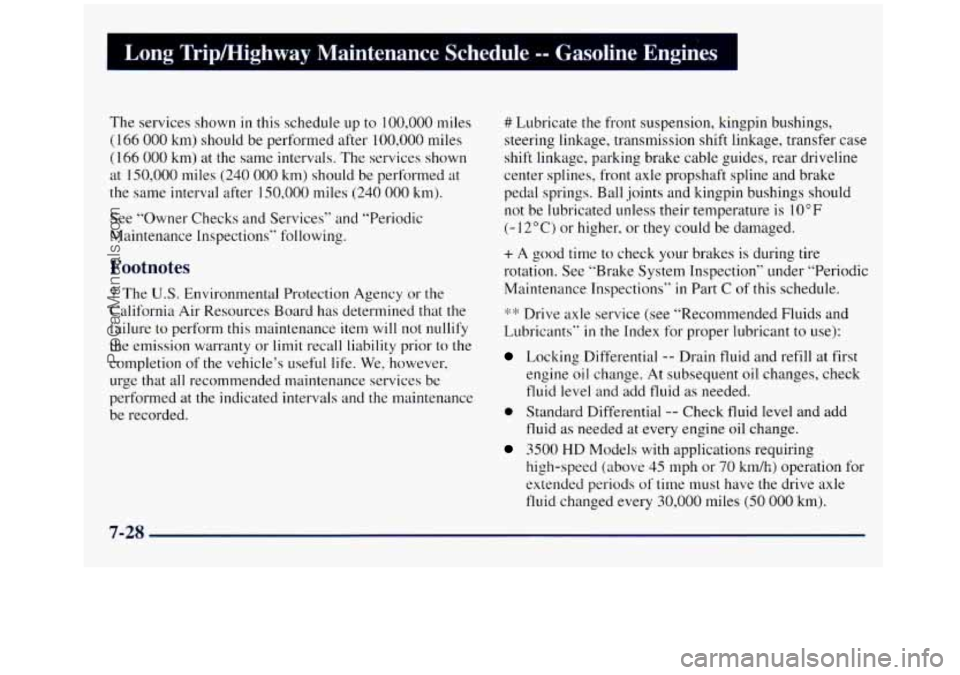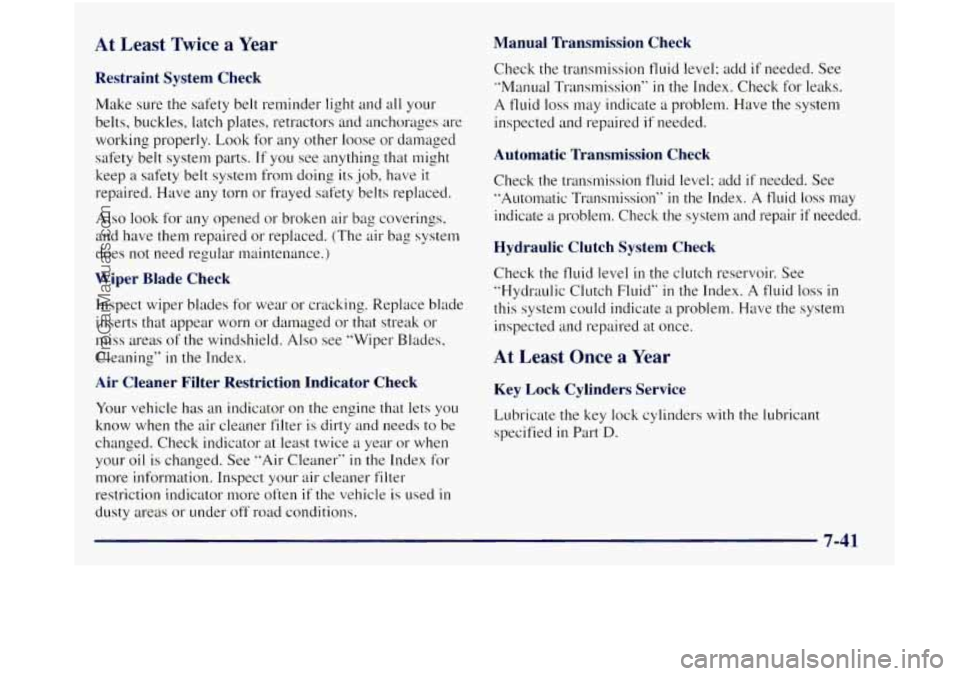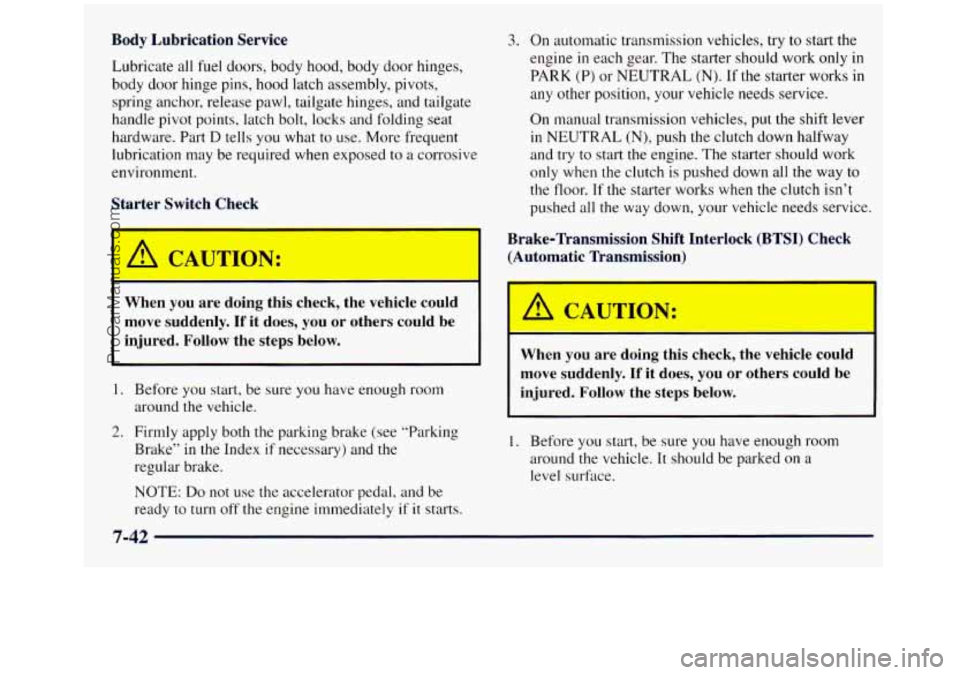1998 GMC SIERRA lock
[x] Cancel search: lockPage 363 of 452

FuseKircuit Breaker
3
4
Usage
Courtesy Lamps, Cargo Lamp,
Glove Box Lamp, Dome/Reading
Lamps, Vanity Mirrors,
Power Mirrors
Instrument Cluster, DRL Relay,
Lamp Switch, Keyless Entry,
Low Coolant Module, Illuminated Entry Module,
DRAC (Diesel Engine)
Not Used
Cruise Control
Auxiliary Power Outlet
Crank
License Lamp, Parking Lamps,
Taillamps,
Roof Marker Lamps,
Tailgate Lamps, Front
Sidemarkers, Fog Lamp Relay,
Door Switch Illumination,
Fender Lamps, Headlamp Switch Illumination
FuseKircuit
Breaker
10
11
12
13
14
15
I6
17
18
19
Usage
Air Bag System
Wiper Motor, Washer Pump
A/C,
A/C Blower,
High Blower Relay
Power
Amp, Cigarette Lighter,
Door Lock Relay,
Power Lumbar Seat
4WD Indicator, Cluster, Comfort
Controls, Instrument Switches,
Radio Illumination,
Chime Module
DRL Relay,
Fog Lamp Relay
Front and Rear Turn Signals,
Back-up Lamps, BTSl Solenoid
Radio (Ignition)
4WAL/VCM, ABS. Cruise Control
Radio (Batterv)
6-73
ProCarManuals.com
Page 364 of 452

Fuse/Circuit Breaker Usage
20
21
22
23
24
A
B
PRNDL, Automatic Transmission,
Speedometer, Check Gages
Warning Light
Security/Steering
Not Used
Not Used
Front Axle,
4WD Indicator Lamp,
TP2 Relay (Gasoline Engine)
Power Door Lock, Six-Way Power Seat, Keyless Entry Module
Power Windows
Underhood Fuse/Relay Center
The underhood fusehelay center is located in the rear of
the engine compartment near the brake fluid reservoir.
Move the retainer clips
for the cover to access the
fuse block.
You can remove fuses with a fuse extractor. The fuse
extractor
is mounted to the interior fuse block. TO
remove fuses
if you don’t have a fuse extractor, hold the
end of the fuse between your thumb and index finger
and pull straight out.
6-74
ProCarManuals.com
Page 365 of 452

STARTER RELAY
[-I
[-I
[T)
I BLOWER
n STOPiHAZ
Name
ECM-B RR DEFOG
IGN-E
FUEL
SOL
GLOW PLUG
Usage
Horn, Underhood Lamps
Auxiliary Fan
Injectors, PCM/VCM
Not Used
Air Conditioning
Not Used
Ignition Switch, EGR, Canister
Purge, EVRV Idle Coast Solenoid,
Heated
02, Fuel Heater
(Diesel Engine), Water Sensor
(Diesel Engine)
HTD ST-RR Not Used
LIGHTING Headlamp and Panel Dimmer
BATT Battery, Fuse Block Busbar
IGN-A Ignition Switch
IGN-B Ignition Switch Switch,
Fog and Courtesy Fuses
ABS Anti-Lock Brake Module
BLOWER High Blower Relay
STOP/HAZ Stoplamps
HEATED SEATS Not Used
6-75
Usage
Fuel Pump, PCM/VCM
Rear Window Defogger
Auxiliary Fan Relay Coi
il, AIC
Compressor Relay, Hot Fuel
Module, Dual Tanks
Fuel Solenoid (Diesel Engine)
Glow Plugs (Diesel Engine)
Name
HORN
AUX FAN
ECM- 1
HTD ST-FR
AIC HTD MIR
ENG-
1
ProCarManuals.com
Page 379 of 452

1 Short Trip/City Maintenance Schedule -- Gasoline Engines I
4:::: Drive axle service (see "Recommended Fluids and
Lubricants"
in the Index for proper lubricant to use):
0 Locking Differential -- Drain fluid and refill at first
engine oil change. At subsequent oil changes, check
fluid level and add fluid as needed.
If driving in
dusty areas or towing a trailer, drain fluid and refill
every
15,000 miles (25 000 km).
Standard Differential -- Check fluid level and add
fluid as needed at every oil change.
If driving in
dusty areas or towing a trailer. drain fluid and refill
every 15,000 miles (25
000 km).
More frequent lubrication may be required for
0 3500 HD Models with applications requiring
heavy-duty
or off-road use.
extreme overload/trailer towing conditions and
high-speed (above
45 mph or 70 km/h) conditions
for extended periods of time must have the drive axle
fluid changed every
30,000 miles (50 000 km).
See "Recommended Fluids and Lubricants" in
this section.
7-9
ProCarManuals.com
Page 398 of 452

Long TripMighway Maintenance Schedule =- Gasoline Engines
The services shown in this schedule up to 100,000 miles
(166 000 km) should be performed after 100,000 miles
(166 000 km) at the same intervals. The services shown
at 150,000 miles (240 000
km) should be performed at
the same interval after 150,000 miles (240 000 km).
See “Owner Checks and Services” and “Periodic Maintenance Inspections” following.
Footnotes
The U.S. Environmental Protection Agency or the
California Air Resources Board has determined that the
failure
to perform this maintenance item will not nullify
the emission warranty or limit recall liability prior to the
completion of the vehicle’s useful life. We, however,
urge that all recommended maintenance services be
performed at the indicated intervals and the maintenance
be recorded.
# Lubricate the front suspension, kingpin bushings,
steering linkage, transmission
shift linkage, transfer case
shift linkage, parking brake cable guides, rear driveline
center splines, front axle propshaft spline and brake
pedal springs. Ball joints and kingpin bushings should
not be lubricated unless their temperature is 10°F
(- 12°C) or higher, or they could be damaged.
+ A good time to check your brakes is during tire
rotation. See “Brake System Inspection” under “Periodic
Maintenance Inspections”
in Part C of this schedule.
‘+‘K Drive axle service (see “Recommended Fluids and
Lubricants”
in the Index for proper lubricant to use):
Locking Differential -- Drain fluid and refill at first
engine oil change.
At subsequent oil changes, check
fluid level and add fluid as needed.
0 Standard Differential -- Check fluid level and add
fluid
as needed at every engine oil change.
3500 HD Models with applications requiring
high-speed (above 45 mph or 70 kndh) operation
for
extended periods of time must have the drive axle
fluid changed every 30,000 miles
(50 000 km).
7-28
ProCarManuals.com
Page 411 of 452

At Least Twice a Year Manual Transmission Check
Restraint System Check
Make sure the safety belt reminder light and all your
belts, buckles, latch plates, retractors and anchorages are
working properly. Look
for any other loose or damaged
safety belt system parts.
If you see anything that might
keep a safety belt system from doing its
job, ha\:e it
repaired. Have any torn or frayed safety belts replaced.
Also look for any opened or broken
air bag coverings,
and have them repaired or replaced. (The air
bag system
does
not need regular maintenance.)
Wiper Blade Check
Inspect wiper blades for wear or cracking. Replace blade
inserts that appear worn
or damaged or that streak or
miss areas
of the windshield. Also see "Wiper Blactes,
Cleaning"
in the Index.
Air Cleaner Filter Restriction Indicator Check
Your vehicle has an indicator on the engine that lets you
know when the air cleaner filter
is dirty and needs to be
changed. Check indicator at least twice
a year or when
your
oil is changed. See "Air Cleaner" in the Index for
more information. Inspect your air cleaner filter
restriction indicator more often
if the vehicle is used in
dusty areas or under off road conditions. Check the transmission fluid
level; add
if needed. See
"Manual Transmission"
in the Index. Check for leaks.
A fluid loss may indicate a problem. Have the system
inspected and repaired
if needed.
Automatic Transmission Check
Check the transmission fluid level: add if needed. See
"Automatic Transmission"
in the Index. A fluid loss may
indicate a problem. Check the system and repair
if needed.
Hydraulic Clutch System Check
Check the fluid level in the clutch reservoir. See
"Hydraulic Clutch Fluid"
in the Index. A fluid loss in
this system could indicate a problem. Have the system
inspected and repaired at once.
At Least Once a Year
Key Lock Cylinders Service
Lubricate the key lock cylinders with the lubricant
specified
in Part D.
7-41
ProCarManuals.com
Page 412 of 452

Body Lubrication Service
Lubricate all fuel doors, body hood, body door hinges,
body door hinge
pins, hood latch assembly, pivots,
spring anchor, release pawl, tailgate hinges, and tailgate
handle pivot points, latch bolt, locks and folding seat
hardware. Part
D tells you what to use. More frequent
lubrication may be required when exposed to
a corrosive
environment.
Starter Switch Check
When you are doing this check, the vehicle could
move suddenly.
If it does, you or others could be
injured. Follow the steps below.
3. On automatic transmission vehicles, try to start the
engine
in each gear. The starter should work only in
PARK
(P) or NEUTRAL (N). If the starter works in
any other position, your vehicle needs service.
On manual transmission vehicles, put the shift lever
in NEUTRAL (N), push the clutch down halfway
and try to start the engine. The starter should work
only when the clutch is pushed down all the way
to
the floor. If the starter works when the clutch isn’t
pushed
all the way down, your vehicle needs service.
Brake-Transmission Shift Interlock (BTSI) Check
(Automatic Transmission)
1. Before you start, be sure you have enough room
around the vehicle.
2. Firmly apply both the parking brake (see “Parking
Brake” in the Index
if necessary) and the
regular brake.
NOTE: Do not use the accelerator pedal, and be
ready to
turn off the engine immediately if it starts.
When you are doing this check, the vehicle could
move suddenly. If
it does, you or others could be
injured. Follow the steps below.
I. Before you start, be sure you have enough room
around the vehicle. It should be parked
on a
level surfxe.
7-42
ProCarManuals.com
Page 413 of 452

2.
3.
Firmly apply the parking brake (see “Parking Brake”
in the Index if necessary).
NOTE: Be ready to apply the regular brake
immediately
if the vehicle begins to move.
With the engine off, turn the key to the
RUN
position, but don’t start the engine. Without applying
the regular brake, try to move the shift lever
out of
PARK
(P) with normal effort. If the shift lever
moves out of PARK (P), your vehicle’s BTSI
needs service.
Ignition Transmission Lock Check
While parked, and with the parking brake set, try to turn
the ignition key to
LOCK in each shift lever position.
With an automatic transmission, the key should turn
to
LOCK only when the shift lever is in PARK (P).
0 With a manual transmission, the key should
turn to
LOCK only when the shift lever is in
REVERSE (R).
On vehicles with a key release button, try to
turn the key
to
LOCK without pressing the button. The key should
turn to
LOCK only when you press the key button.
On
all vehicles, the key should come out only in LOCK.
Parking Brake and Automatic Transmission
PARK (P) Mechanism Check
When you are doing this check, your vehicle
could begin to move. You or others could be
injured and property could be damaged. Make
sure there
is room in front of your vehicle in case
it begins to roll. Be ready
to apply the regular
brake at once should the vehicle begin to move.
Park on a fairly steep hill, with the vehicle facing
downhill. Keeping your foot on the regular brake, set the
parking brake.
0 To check the parking brake’s holding ability:
With the engine running and transmission
in
NEUTRAL (N), slowly remove foot pressure from
the regular brake pedal.
Do this until the vehicle is
held by the parking brake only.
0 To check the PARK (P) mechanism‘s holding ability:
With the engine running, shift to
PARK (P). Then
release all brakes.
7-43
ProCarManuals.com